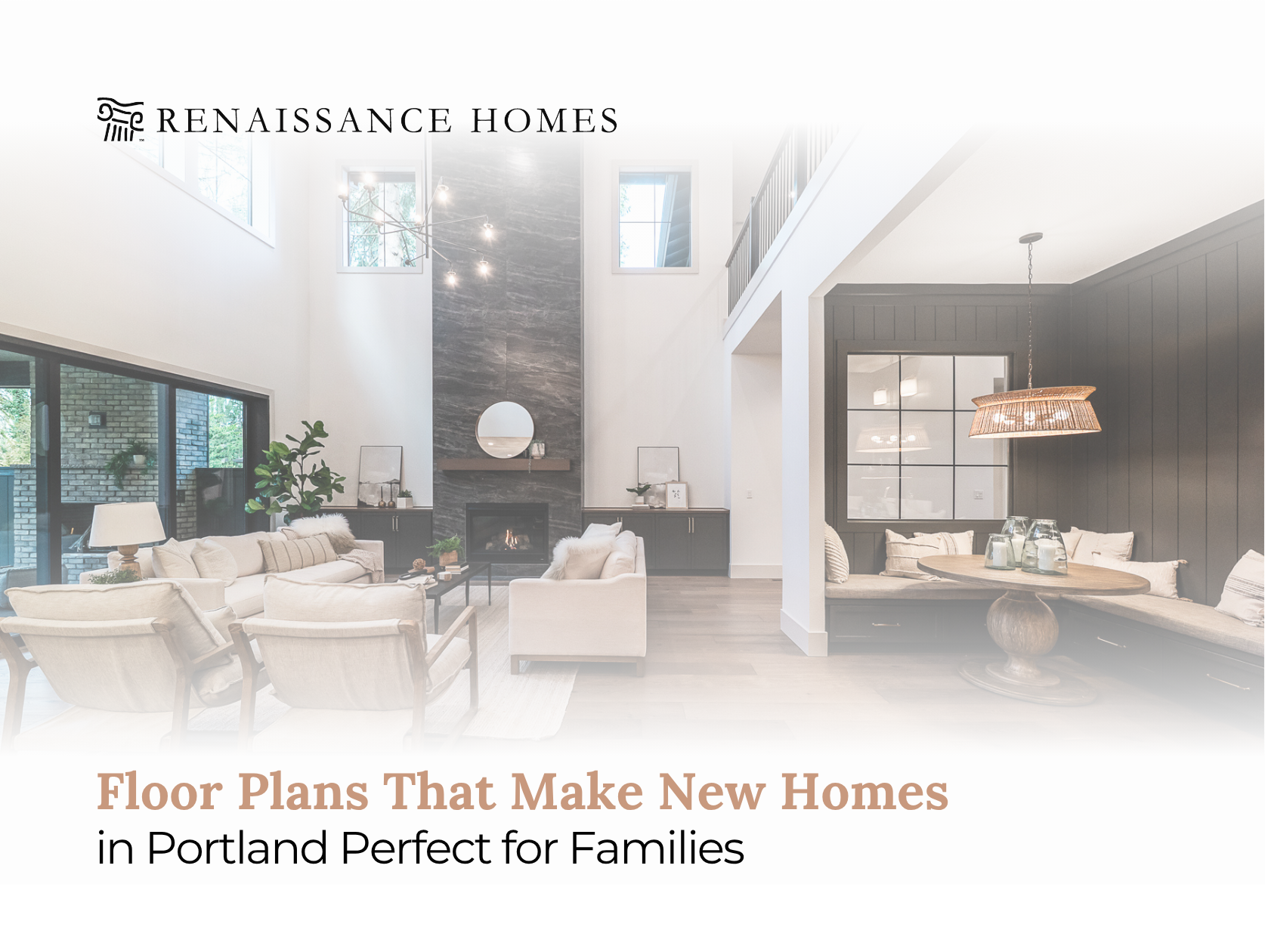Finding the right floor plan for your family’s new home is one of the most crucial decisions you’ll make in the home buying or building process. Portland families have unique needs that require thoughtful consideration of space, functionality, and lifestyle requirements. The perfect floor plan goes beyond square footage to encompass how your family lives, grows, and connects in your daily life.
Today’s families are looking for homes that can adapt to their changing needs while providing comfort, efficiency, and spaces for both togetherness and privacy. Whether you’re planning for a growing family, working from home, or hosting extended family gatherings, the right floor plan can make all the difference in creating a home that truly works for your lifestyle.
Understanding Family-Friendly Floor Plan Basics
When evaluating new homes Portland floor plans, it’s essential to consider both your current needs and future requirements. A well-designed family home should offer flexibility and functionality that can evolve with your family over time. The best floor plans strike a balance between open gathering spaces and private retreats, ensuring everyone has room to thrive.
Key considerations include traffic flow patterns, sight lines for supervising children, and the relationship between different living spaces. For instance, having the kitchen open to the family room allows parents to prepare meals while keeping an eye on children doing homework or playing. Similarly, placing bedrooms in strategic locations can provide quiet zones for rest while maintaining easy access for nighttime needs.
The Rise of Open-Concept Living for Modern Families
Open-concept homes Portland have become increasingly popular among families for good reason. These designs create expansive living areas that promote family interaction and make homes feel larger and more inviting. By removing walls between the kitchen, dining, and living areas, families can stay connected throughout their daily activities.
The benefits extend beyond aesthetics. Open floor plans allow natural light to flow throughout the space, creating bright, welcoming environments that enhance mood and reduce energy costs. They also provide flexibility for furniture arrangements and can easily accommodate large gatherings or holiday celebrations. Parents particularly appreciate the ability to supervise children from multiple vantage points while going about household tasks.
However, successful open-concept design requires thoughtful planning. Consider incorporating defined zones within the open space using furniture placement, area rugs, or subtle architectural features like ceiling treatments or partial walls. This approach maintains the openness while creating distinct areas for different activities.
Essential Spaces for Growing Families
Family-friendly homes Portland require certain spaces that support daily life and special occasions alike. The kitchen often serves as the heart of the home, so it should be designed with ample counter space, storage, and room for multiple cooks. An island or peninsula can provide additional prep space while creating a natural gathering spot for quick meals or homework sessions.
A dedicated mudroom or entry area helps manage the chaos of active family life. This space should include storage for coats, shoes, backpacks, and sports equipment, helping to keep the rest of the home organized. Consider adding a bench for putting on shoes and hooks at child-appropriate heights to encourage independence.
Home offices have become essential for many families, whether for remote work or as a quiet space for focused tasks. Positioning this room near the main living areas allows parents to work while staying connected to family activities, yet with enough separation to minimize distractions during important calls or meetings.
Smart Storage Solutions in Modern Layouts Portland Homes
Effective storage is crucial for maintaining an organized, functional family home. Modern floor plans incorporate creative storage solutions throughout the house, from built-in shelving to walk-in pantries and dedicated closet systems. These features help families manage their belongings without cluttering living spaces.
Consider floor plans that include a large pantry adjacent to the kitchen, linen closets on each floor, and bedroom closets sized appropriately for each family member. Bonus storage areas like under-stair closets, attic access, or basement storage rooms provide space for seasonal items, holiday decorations, and rarely used equipment. Well-planned storage reduces daily stress and helps maintain the home’s aesthetic appeal.
Bedroom Configuration for Family Comfort
The arrangement and size of bedrooms significantly impact family comfort and privacy. Master suites positioned away from children’s rooms provide parents with a peaceful retreat while still maintaining proximity for nighttime needs. Consider custom floor plans Portland that place younger children’s rooms near the master suite, with space for older children or guests on another level or wing of the home.
Secondary bedrooms should be sized to accommodate furniture beyond just a bed and dresser. Children need space for desks, play areas, and storage for toys and clothes. Jack-and-jill bathrooms between bedrooms can maximize efficiency while teaching children to share and respect each other’s space. For families planning to age in place, consider including a main-floor bedroom that could serve various purposes over time.
Multi-Functional Spaces That Grow With Your Family
The most successful family floor plans include flexible spaces that can adapt to changing needs. A bonus room might serve as a playroom for young children, transform into a teen hangout space, and eventually become a home gym or hobby room. These multi-functional areas provide valuable square footage that can be reimagined as your family evolves.
Finished basements offer excellent opportunities for creating adaptable spaces. They can house entertainment areas, guest suites, or even separate living quarters for adult children or aging parents. When planning these spaces, consider including rough-in plumbing for future bathrooms and multiple egress options for safety and potential bedroom conversions.
Indoor-Outdoor Living Connections
Portland’s natural beauty and mild climate make indoor-outdoor connections particularly valuable for families. Floor plans that incorporate covered patios, decks, or courtyards extend living space and provide safe areas for children to play while remaining visible from inside. Large windows and sliding doors create seamless transitions between indoor and outdoor spaces.
Consider how outdoor spaces relate to interior rooms. A deck off the kitchen facilitates outdoor dining, while a patio accessible from the family room creates an extended play area. For families with young children, fenced yards visible from main living areas provide peace of mind. These outdoor living features add value and enhance daily life throughout the seasons.
Energy Efficiency in Family Floor Plans
Sustainable design benefits both your family and the environment. Open-concept homes Portland often feature excellent natural light, reducing the need for artificial lighting during the day. Efficient floor plans minimize wasted space and can significantly reduce heating and cooling costs. Consider designs that position living spaces to take advantage of passive solar heating and cooling.
Modern energy-efficient features like high-performance windows, proper insulation, and smart home systems can be seamlessly integrated into any floor plan. These elements not only reduce utility costs but also create more comfortable living environments with consistent temperatures and improved air quality. Many Portland builders now prioritize sustainable construction methods that benefit families for years to come.
Technology Integration for Modern Family Life
Today’s new homes Portland floor plans must accommodate our increasingly connected lifestyles. Consider layouts that include dedicated spaces for charging stations, built-in desk areas for virtual learning, and appropriate wiring for home entertainment systems. Strategic placement of outlets and USB ports throughout the home prevents the common frustration of searching for places to plug in devices.
Smart home technology can enhance family safety and convenience. Features like video doorbells, smart locks, and integrated security systems provide peace of mind, while programmable thermostats and lighting systems improve comfort and efficiency. When selecting a floor plan, think about how technology will be used in each space and ensure the infrastructure supports your family’s needs.
Evaluating Floor Plans: A Family Perspective
When reviewing floor plans, involve all family members in the discussion. Walk through the layout mentally, imagining your daily routines and special occasions. Consider questions like: Where will holiday dinners be hosted? Is there adequate space for homework and projects? Can the home accommodate overnight guests comfortably?
The following factors deserve special attention when selecting family-friendly floor plans:
- Traffic flow between high-use areas like bedrooms, bathrooms, and the kitchen
- Noise control between active and quiet spaces
- Natural light in primary living areas and bedrooms
- Flexibility for furniture arrangements and future modifications
- Accessibility features that may become important as family members age
Popular Floor Plan Trends for Portland Families
Current trends in modern layouts Portland homes reflect changing family dynamics and lifestyle preferences. Split-bedroom designs that separate the master suite from secondary bedrooms remain popular for privacy. Two-story homes with first-floor master suites accommodate multi-generational living while providing independence for older children upstairs.
Great rooms that combine living, dining, and kitchen areas continue to dominate family-friendly homes Portland, but with more sophisticated space definition. Designers use architectural elements like coffered ceilings, built-in shelving, and kitchen islands to create distinct zones within open floor plans. Home offices and flex spaces have become standard rather than luxury features.
Cost Considerations for Family Floor Plans
While spacious floor plans offer numerous benefits, it’s important to balance desires with budget realities. Larger homes require more resources to build, furnish, maintain, and heat or cool. Focus on quality over quantity by prioritizing the spaces your family will use most rather than simply maximizing square footage.
Efficient design can make smaller homes feel spacious and functional. Features like nine-foot ceilings, large windows, and smart storage solutions create an sense of openness without adding significant cost. Work with experienced builders who can suggest modifications to standard floor plans that better suit your family’s specific needs without breaking the budget.
Making the Final Decision
Choosing the perfect floor plan requires careful consideration of numerous factors. Beyond the practical elements, consider how the home will feel to live in daily. Does the layout promote the kind of family interaction you desire? Will it accommodate your lifestyle both now and in the future? These emotional and experiential factors are just as important as room sizes and technical specifications.
Take time to visit model homes and walk through different floor plans. Many builders offer virtual tours or 3D renderings that help visualize spaces. Don’t hesitate to ask questions about modifications or customizations that could better serve your family’s needs. The right floor plan will feel like home even before the first wall is built.
Why Hire Renaissance Homes for Your Family’s Custom Floor Plans Portland
Locally owned and operated for over four decades, Renaissance Homes understands what Portland families need in their dream homes. As the most awarded builder in Street of Dreams history, we specialize in creating custom floor plans Portland that perfectly match each family’s unique lifestyle and requirements. Our experienced team works closely with you to design spaces that grow and adapt with your family’s changing needs.
Our award-winning design team brings expertise in creating family-friendly homes Portland that balance beauty with practicality. From open-concept homes Portland to traditional layouts, we craft each home with meticulous attention to detail and premium materials. Our proven building process ensures your vision becomes reality while maintaining the highest standards of quality and craftsmanship.
Renaissance Homes transforms dreams into reality by combining innovative design with timeless elegance. We understand that your home is more than just a structure; it’s where memories are made and families flourish. When you choose Renaissance Homes, you’re investing in a legacy of excellence and a partner committed to creating the perfect backdrop for your family’s story.
Frequently Asked Questions
What size floor plan is ideal for a family of four?
The ideal size depends on your lifestyle rather than family size alone. Many families of four thrive in 2,000-2,500 square foot homes with efficient layouts. Focus on having adequate bedrooms, bathrooms, and living spaces rather than maximum square footage. A well-designed smaller home often functions better than a poorly planned larger one.
How important is a separate dining room in modern floor plans?
Formal dining rooms have become less critical as open-concept designs gain popularity. Many families prefer eat-in kitchens with adjacent dining areas that can serve both casual meals and formal occasions. Consider your entertaining style and frequency of formal dinners when deciding if a separate dining room is necessary.
Should we prioritize a larger yard or more indoor living space?
This decision depends on your family’s lifestyle and the ages of your children. Families with young children often benefit from outdoor play space, while those with teenagers might prefer additional indoor areas. Portland’s climate allows for year-round outdoor enjoyment, making covered outdoor spaces a valuable compromise.
What’s the minimum number of bathrooms for a family home?
Most family homes benefit from at least 2.5 bathrooms: a master ensuite, a shared full bathroom for bedrooms, and a powder room for guests. Larger families or homes with multiple floors often require additional bathrooms to prevent morning bottlenecks and provide convenience.
How can we future-proof our floor plan selection?
Choose flexible spaces that can be repurposed as needs change, include a main-floor bedroom option for aging in place, and ensure doorways and hallways can accommodate mobility devices. Consider universal design principles that benefit all ages and abilities while maintaining aesthetic appeal.



